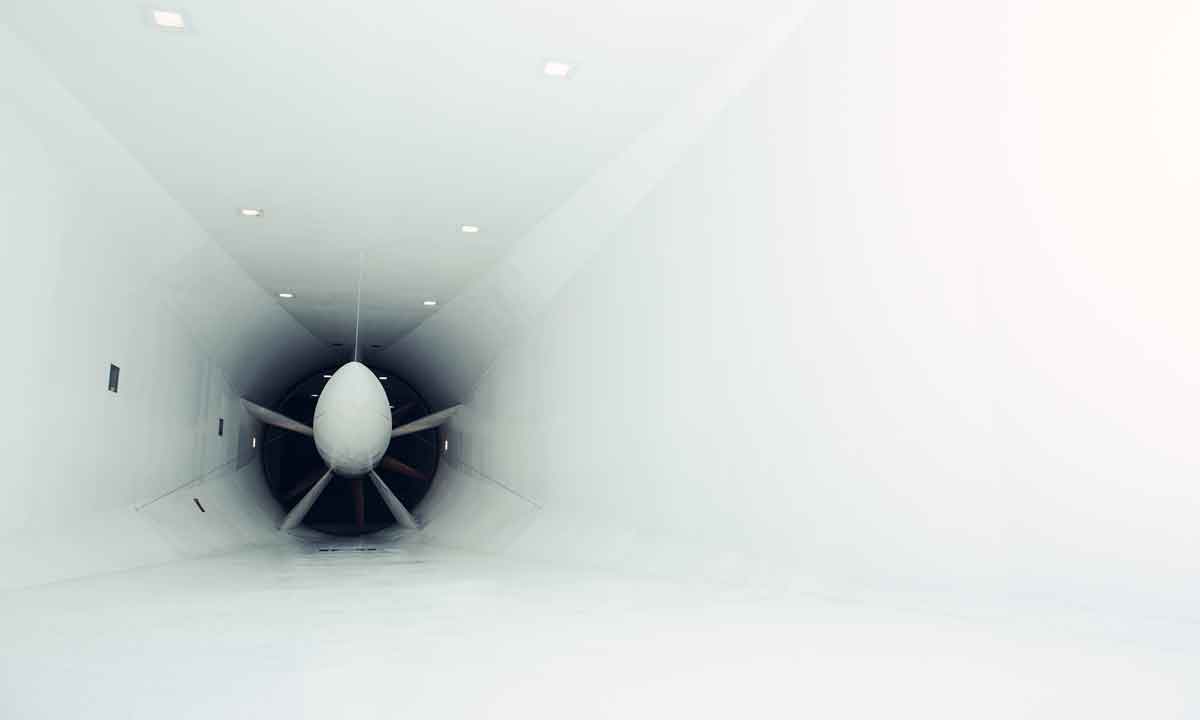Inside the San Diego Wind Tunnel
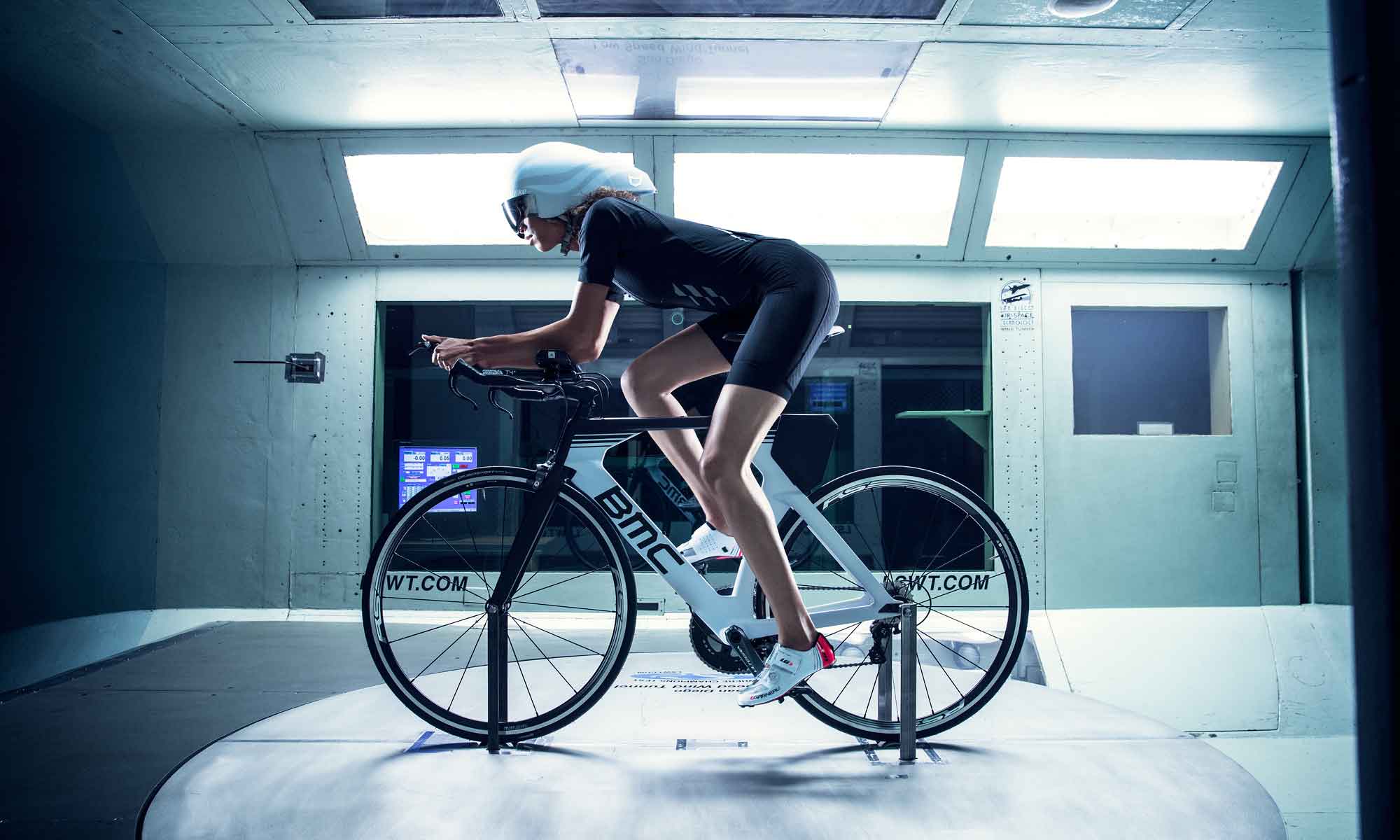
Photo: John Trice
The San Diego Wind Tunnel is where world champions honed their aero positions and the sport’s hottest tech took flight. Roy M. Wallack gets a peek inside the World War II relic where triathlon legends were born.
I’m aero. Down on my aerobars, in my aero helmet, I’m splitting the wind, spinning like a metronome, deep in my endorphin dream state, when suddenly I’m startled by the roar of an airplane so close that it’s surely about to smash me into smithereens.
At least, it seems like it. I’m spinning my wheels at the San Diego Air and Space Technology Center Wind Tunnel, located next to the city’s airport. The pulverizing scream of massive jet engines reverberates through this low-ceilinged, windowed room, buried in the belly of a cavernous white building. While you quickly learn to ignore the noise, it serves as a reminder that the original purpose of this place was not shaping sleek bikes and body positions but fine-tuning aircraft variously designed to fly us to Hawaii on vacation or bomb the hell out of fascists, communists and fundamentalists.
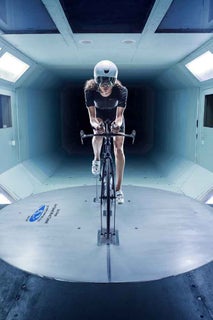
Built by Westinghouse during the last two years of World War II in 1944–45, the Low Speed Wind Tunnel opened its doors to cyclists in 2003 and quickly became a scene of long-course triathlon legend—where the top triathletes tested and the hottest tech was invented.
Three-time Hawaii Ironman winner Mirinda Carfrae tested here. So did Kona kings Craig Alexander and Chris McCormack. Ditto Germany’s Faris Al-Sultan, 2005 Hawaii champ, and Normann Stadler, 2004 and 2006 Kona winner. You name it, they came here: Fernanda Keller, the Brazilian multi-time podium finisher; all-time great Michellie Jones. In fact, eight-time Hawaii winner Paula Newby-Fraser was the first rider in the tunnel in 2003, when LSWT management decided to open it to bikes.
“We were looking for more work beyond the aeronautical companies, and a friend mentioned to me how triathlon is so popular in San Diego,” says Dave Sanford, the facility’s longtime aerotest engineering manager, now retired and a part-time consultant. “It was pure luck. I sent a blind email to Paul Huddle, who runs the Multisports coaching and training camps—and he wrote back that he had no idea that there was a tunnel in San Diego.”
No surprise there. The building had barbed wire around it and had no identifying sign. Its work for the military was not advertised.
The LSWT claimed several advantages over the popular tunnel at Texas A&M University and two dozen others around the country, starting with perfect year-round San Diego weather that allowed bikes and riders to tunnel test, then try out the new position an hour later at Mission Bay’s nearby car-free Fiesta Island. It specialized in designing wind-tunnel balances, the load-measuring turntable the bikes are placed on, allowing for accurate, repeatable data—a key to comparing results from several test dates. Every wind tunnel uses a balance to derive the all-important drag figures, but the LSWT’s is considered more accurate by many. And, finally, of course, there’s convenience: It was in the backyard of thousands of triathletes, pro cycling training camps and bikemakers.
“It was a symbiotic relationship and a refreshing engineering challenge for us,” Sanford says. “We had never worked on machines that had moving parts—humans—attached to them.” Huddle, coaching partner Roch Frey and their respective pro wives, Newby-Fraser and Ironman champion Heather Fuhr, schooled Sanford and his crew on the relationship between power and drag. That’s how Newby-Fraser, an expert in rider setup, became the tunnel’s first rider.
The word quickly got out to the bike industry. Steve Hed began bringing in his aero wheels, the Continental Pro Racing Team tested five riders, and bikemakers like Felt, Cervélo and Trek became regulars. Trek finalized the Speed Concept TT bike in the tunnel, Cervélo tested prototypes of the P5, P6 and P7 there, and the aero-obsessed and since disgraced cyclist Lance Armstrong started showing up, forcing teammates and competitors to do the same.
Very quickly, the testing pointed out the conflict between aero efficiency and comfort/performance. “While the ideal aero position is low and long, we soon found out that four out of five people actually got slower in it,” Sanford says. “They just couldn’t hold such a radical aero position.” So his strategy became moving riders toward the ideal in incremental steps. Not surprisingly, he found that pros, already fairly dialed in, made slower, smaller changes than new riders more open to changes.
And yet there was a pro position breakthrough of sorts at the LSWT in 2006, when pro cyclists Floyd Landis and Levi Leipheimer tested one of the strangest, effective and short-lived time-trial positions of all time: the Praying Mantis. It involved tilting the aerobars up at an angle and burying the head between the arms—“completely taking the head out of the [turbulence] equation,” Sanford says. The eyes-facing-down position, although significantly faster than a standard aero/TT position, was deemed dangerous by the UCI, which soon eliminated it by decreeing that aerobars had to be level.
Incidentally, what the UCI banned for road racing, sheer discomfort makes worthless for Ironman. “Bottom line,” says Anton Petrov, the aero expert at Felt and a frequent visitor to the San Diego wind tunnel, “a pro TT rider can suffer for an hour, but in an Ironman you have to hold that position for five hours.” In other words, there has to be a balance between comfort and aerodynamics, which is why triathletes may not go as aero as pure time-trialists.
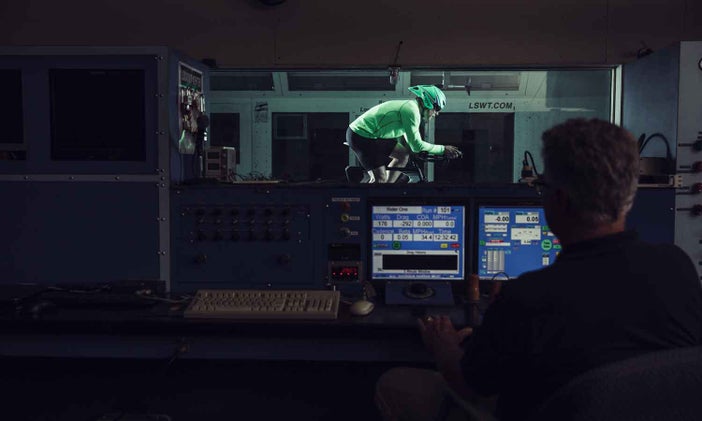
Fatter Aero Wheels
Just down the hallway from the control room’s circa-1940 cluster of Buck Rodgers gauges and dials is “The LSWT Hall of Fame.” On one side are triathletes; on the other wall are pro cyclists—American star Leipheimer; two-time Tour de France winner Alberto Contador; even America’s greatest cyclist, triple Tour winner Greg LeMond. There’s Kristin Armstrong, the three-time Olympic time-trial gold medalist, revered by the LSWT brass because she perfected her final position here for her monumental five-second win in Rio last year at age 42. And last but not least, there are three shots of Lance what’s-his-name, no-relation-to-Kristin—one of them a group shot with 15 fawning assistants and trainers and wind-tunnel engineers crammed beside him, beaming toothy smiles.
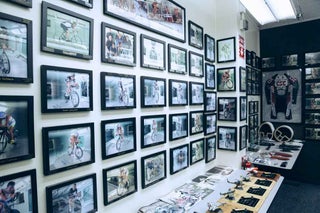
Despite the glamorous Hall of Fame names, the bulk of the LSWT’s cycling and triathlon work comes from the product side. Fittingly, one of the most influential discoveries came from a bike engineer with an aerospace background.
“In the ’90s and into the next decade, we all thought that the best aero wheels were skinny and streamlined,” says Dino Edin, now chief of product and strategy at HED Cycling Products. “It was all about cutting through the air. Then, at the wind tunnel in San Diego one day in ’07, it dawned on me that the numbers we were seeing said that we needed to generate lift in the wheel—not streamlining.”
Some background: Edin was an aeronautics buff who studied flight in college. He saw that a wheel being hit by sidewinds could be driven forward if it generated lift, the same concept used in both flight and sailing. Wind on a sail generates a sideways force that is converted into lift or forward movement when it is counteracted with a rudder and keel. On a bike, your deep-dish rim is the sail, and your rudder is your body lean against the wind.
“That was a breakthrough—an ‘aha’ moment,” Edin says. “No one had ever talked about wheels in that way.”
When air does not stay attached to a wing or a sail, you stall. In a plane, a stall means you fall out of the sky. On a boat, a stall means you stop going forward. On a bike wheel, a stall makes you go slower, requiring more power to maintain speed. As tires began to get wider in the last decade (due to more comfort and less rolling resistance), the wheel aerodynamics actually got worse with a skinny rim.
There was only one solution. “To keep the air attached, we had to widen the rims, because skinny aero wheels stalled super fast—even HED wheels,” Edin says. “So we made prototypes, and they crushed it.”
Edin and Steve Hed shared a patent for widened rims in 2008. “It was an ace up our sleeves for a long time,” Edin says. “The competition still had skinny rims. We were destroying everyone by huge amounts—20 watts.”
That year, HED introduced the 23mm Ardennes wheel, the first wide clincher design, as well as the first true wide tubular wheel, the 28mm wide Stinger 60. Sales were impressive and copycats abounded. Edin proudly reports that Specialized now licenses fat aero rims from HED.
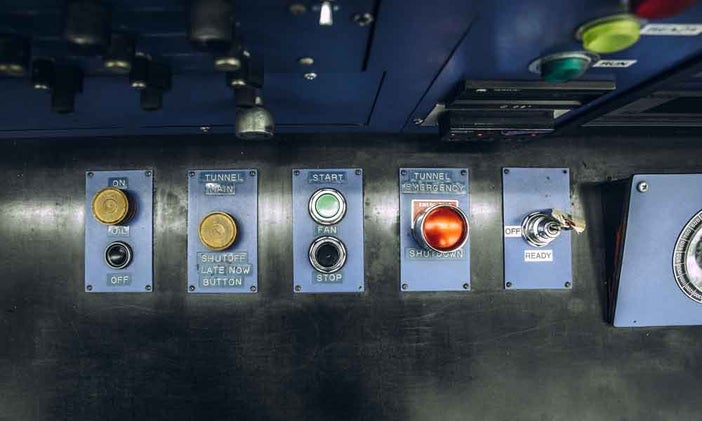
But at least one discovery at the SD wind tunnel was a total fluke. When a test bike got a flat tire one day at the LSWT about five years ago, Felt Bikes owner Jim Felt ran down to the Nytro retail shop to pick up a new tire and got a surprise. “Suddenly, with the new tire, the drag numbers went down—by 100 grams!” Felt says. “That’s a ton. It’s three times as much as hiding brake cables with a cowling. That got us interested in designing tires.” The result: The specially designed Felt TTR has been the standard tire on Felt tri bikes for four years. Tested, naturally, at the SD wind tunnel.
What’s Next
A major aerodynamics breakthrough along the lines of the aerobar may not be in the cards, but smaller changes will continue as trends come and go—and come again. HED’s fat wheel revolution is a good example of the continual evolution in bike design and why bike designers still head to the wind tunnel, even as digital modeling and sensor-driven testing improves.
“Storage. Non-traditional frame shapes. Tires. Disc brakes for road bikes and tri bikes. Surprising changes in tires. Downtubes that wrap around front wheels. We’re still learning,” Petrov says. “Changes are more incremental now, but non-stop.”
Disc brakes will keep guys like Petrov busy, he admits, given that triathletes have long had “brake issues,” and discs will require new frames that have to be made more aerodynamic themselves. Radical new frame designs like the Diamondback Andean and beam-bike throwbacks like the Dimond Marquise and the Cervélo P5X have to be tested and analyzed.
Aerodynamic storage compartments for food, tools and water, popularized five years ago by the Speed Box on Trek’s Speed Concept, are fast becoming standard elements in aero bike design. “That area of the bike—rear wheel, seat tube, seat juncture—has a lot of turbulence, so we need to give the air guidance,” says Mio Suzuki, the Trek analysis engineer who oversees wind-tunnel testing. She directed the Speed Box’s redesign to match an upgraded 2014 frame and now even utilizes an anthropomorphic dummy, Manny the Mannequin, to test bikes. (He’s “much more consistent after a few hours than a human,” she says.) In-frame water storage is another area drawing a lot of interest, partially spurred by Specialized’s new patent on internal flexible bladder storage.
Ultimately, design software may get better and better, but aerodynamicists like Suzuki, Petrov and Edin will never be desk-bound. They all agree that they will need final validation from the tunnel. And no matter the equipment, riders can always learn something.
“Out of hundreds of riders we’ve tested, only two or three nailed their ideal aero position on their own, says LSWT’s Dave Sanford.
How the Wind Tunnel Works
At the LSWT, a bike rider does not pedal directly toward a massive propeller that looks like it could suddenly reverse direction and puree him. This facility utilizes a “closed-circuit” design in which its giant, six-bladed, 20-foot-diameter wooden fan, powered by a 2,250-horsepower electric motor, sits in another part of the building, blowing wind clockwise through a sealed rectangular loop. Like water passing through the tapered nozzle of a garden hose, the wind speeds up as it squeezes through a narrowed cross-section of the loop. It can reach a uniform velocity of up to 270 mph through the cramped test section, just 8 feet high, 12 feet wide and 15 feet long. The top speeds simulate aircraft takeoffs and landings. A test bike/rider will ride into 25 to 30 mph winds.
LSWT’s loop design offers several qualitative advantages over the simpler straight-line “open circuit” design of some other tunnels, including lower noise and infiltration by dust and air leaks from vents and windows. In fact, its electric engine is so “clean” that the parts don’t wear out. Proof: The wooden fan blades, normally vulnerable to damage, haven’t been replaced in 70 years.
While that’s impressive, Bike-industry aerodynamicists keep coming back to LSWT for its renowned “balance,” the floor-mounted, 106-inch-diameter steel turntable and roller the bike is affixed to. Basically a hyper-sensitive scale, the balance is full of sensors that measure deflection, force and the single metric that matters most for aerodynamics: drag. Super-accurate (to +/- 5 grams), the LSWT offers dense data collection (10 samples/second) that allows engineers to clearly see how much the bike is moving in space (up/down, back/forth and left/right) as it passes through the wind. Equally important, the readings are consistent year after year, assuring that all the test results are valid and comparable.
